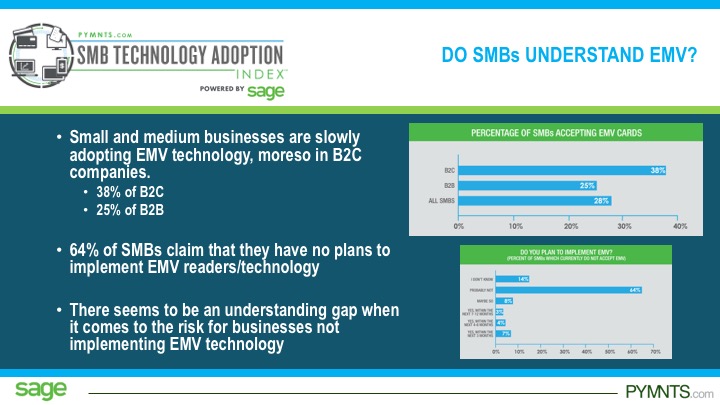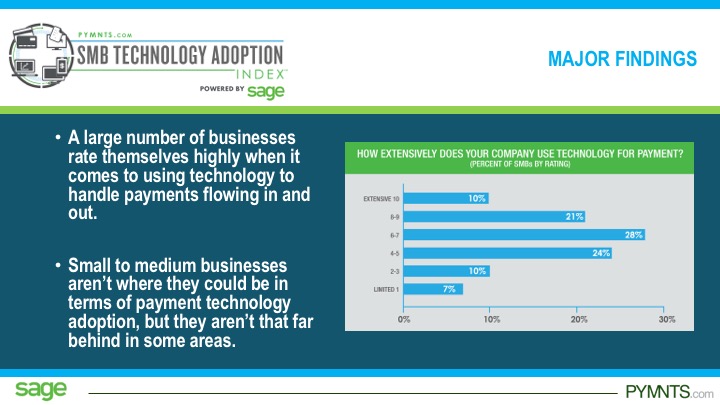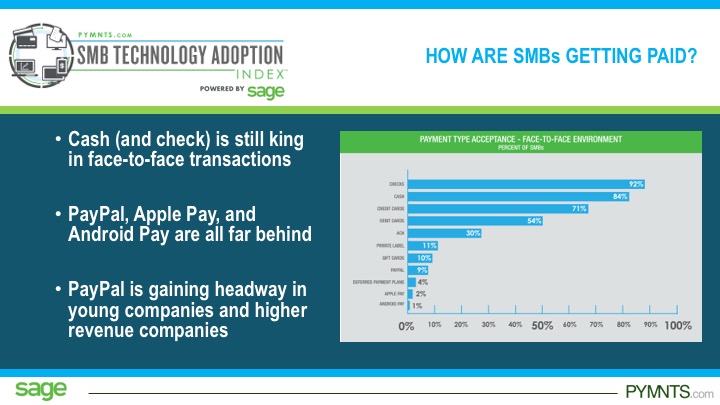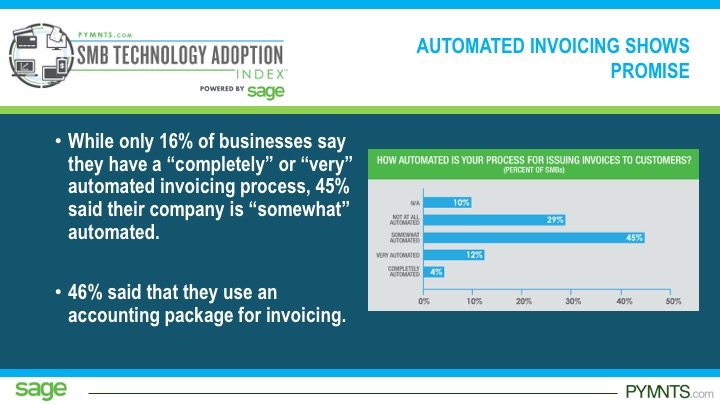The SMB Innovation Perception/Reality Adoption Gap

SMBs think that they’re on the forefront of new payments and business process innovation, but the reality is anything but. Sage Payments CEO Paul Bridgewater and MPD CEO Karen Webster hosted a digital discussion last week in which the results of the latest SMB Technology Adoption Index were explained, debated – and ultimately used to construct a roadmap so that reality matches perception.
ShutterstockSMBs think that they’re on the forefront of new payments and business process innovation, yet the reality is anything but. Sage Payments CEO Paul Bridgewater and MPD CEO Karen Webster hosted a digital discussion last week in which the results of the latest SMB Technology Adoption Index were explained, debated – and ultimately used to construct a roadmap so that reality matches perception.
Though SMBs are well aware of the new technologies and innovations available to help make their businesses more secure and streamlined, they still lack an understanding of how important these measures are and exactly how they can get there.
And, the biggest competition for the adoption of these technologies actually isn’t other technologies in the market – it’s the small businesses themselves.
That was the topic of conversation when Bridgewater and Webster spoke last week. At the center of this conversation was the results of the PYMNTS.com SMB Technology Adoption Index and the 684 SMBs who participated in it. They – and this Index – shed some interesting new light on what it will take to make technology adoption tick for the SMBs that need it the most.
When it comes to how extensively their company uses payment technology, only 30 percent of respondents rated themselves highly. According to Bridgewater, therein lies the greatest opportunity – one that helps bridge the gap between awareness that solutions exist and an understanding of how to put them to work.
And, it starts, Bridgewater says, with the payments industry.
“That to me says there is a huge educational opportunity with SMBs on the benefits of adopting solutions to help them automate their business,” Bridgewater said, adding that many companies continue to struggle with fragmented solutions – lots of single point solutions that create data and process integration headaches.
That only forces SMBs to piece together solutions themselves. In the meantime, businesses are resource-constrained and at the end of the day are just looking for “integrated and payments-embedded solutions that simplify their life – and just work,” Bridgewater added.
OPERATING IN A CASH AND CHECK WORLD
The payments industry may be in denial, but research shows that cash and paper check payments continue to reign supreme for SMBs when it comes to face-to-face transactions.
The march to digital just hasn’t started with the SMB – at least just yet.
According to the SMB Technology Adoption Index, nearly 92 percent of SMBs accept paper checks and 84 percent accept cash in a face-to-face environment.
One the most surprising findings was how little of an impact mobile payments are making in the word of small and medium-sized businesses. Overall, only 20 percent of SMBs actually accept mobile payments, but in a face-to-face environment those percentages drop drastically.
While mobile is starting to gain interest within SMBs, its progress doesn’t hold a candle to that being made by alternative payment methods like ACH, which is accepted by around 30 percent of SMBs now and is expected to continue growing at an average of about 5 percent annually.
“We might not like to hear this as we look to fabulous opportunities to innovate within the payments space. Sometimes you just have to take a step back and look at what matters to SMBs and you’ve got to enable SMBs to meet their customers where their customers want to be met,” Bridgewater explained.
THE EMV EDUCATIONAL GAP
 The EMV liability shift poses a big risk to small to medium-sized businesses. Despite this fact, the SMB Technology Adoption Index found that SMBs still aren’t prepared.
The EMV liability shift poses a big risk to small to medium-sized businesses. Despite this fact, the SMB Technology Adoption Index found that SMBs still aren’t prepared.
“A whopping 64 percent — that’s almost two-thirds of all SMBs within our Index — are not ready to accept EMV transactions and more interestingly they do not currently have plans to do so,” Bridgewater revealed.
SMBs may not be ready, but the EMV migration will continue to march on. According to data from Visa, within four to five years 90 percent of transactions in the U.S. are predicted to be chip card-based transactions.
The understanding gap is not hard to fathom: SMBs are busy running their companies day-to-day, and EMV is not a pain point that pops to the top of their list.
But just as the liability shifted from card-issuer to merchant, a shift of the same magnitude is needed in the mindset of small business owners.
As Bridgewater noted, “this tells us from a payments perspective that EMV is very much right at the start of its inception and we have a long road ahead of us. We need to ensure that we are providing products, solutions and education that enables SMBs to navigate that road cleanly and effectively on a timeframe that makes sense to them.”
CREATING CASH FLOW CONFIDENT BUSINESSES
One of the biggest pain points for small businesses — as well as what should probably be a huge driving force in technology adoption — is late payments.
Cash flow is the lifeline of small to medium-sized businesses, which makes unforeseen impacts to the management of cash flow a potentially detrimental occurrence.
Small businesses owners need to have a clear understanding of what is flowing in and out of their businesses, and late payments “contribute directly to cash flow uncertainty,” Bridgewater explained.
While there are opportunities for SMBs to embrace new technologies geared toward helping them accelerate the rate at which they receive payments, it was a surprising result of the SMB Technology Adoption Index to find that small business owners are still not taking advantage of them.
Integrated and embedded payment acceptance solutions have the potential to help SMBs with the movement of money – that’s getting paid, making payments and managing money.
Automated invoicing is a step in the right direction to more efficiently manage cash flow, but according to the Index just 16 percent of SMBs believe they have “completely” or “very” automated invoicing processes in place.
Roughly 45 percent said their company is “somewhat” automated, meaning they may issue electronic invoices, but they’re not getting paid electronically on the back of that invoice.
“Small to medium-sized businesses are aware that they can accept payments, but they’re not necessarily aware that those payments can be posted back in real-time, automatically and directly into their accounting software,” Bridgewater said.
It seems as though the building blocks are in place to streamline and automate payment management, but SMBs still have a long way to go.
The reluctance to pursue new technologies is standing in the way, but what will it take to knock down that wall?
“There’s a level of trust that still needs to be built in to enable SMBs to adopt the type of technology that will enable them to get paid faster and more efficiently,” Bridgewater said.
But he also noted that there is still a low number of payment solutions in the market for SMBs that are effective, user-friendly, highly adoptable and trusted.
While the Index showed there is still room for significant shifts in both education and payment method acceptance, Bridgewater confirmed that there is still hope for growing the amount of technology adoption within the small to medium-sized business landscape.
“It’s the perfect environment for innovation to happen, but it has to be at the forefront of an SMB’s thinking,” he stated.
To watch the full webinar replay, please click the video shown below.




